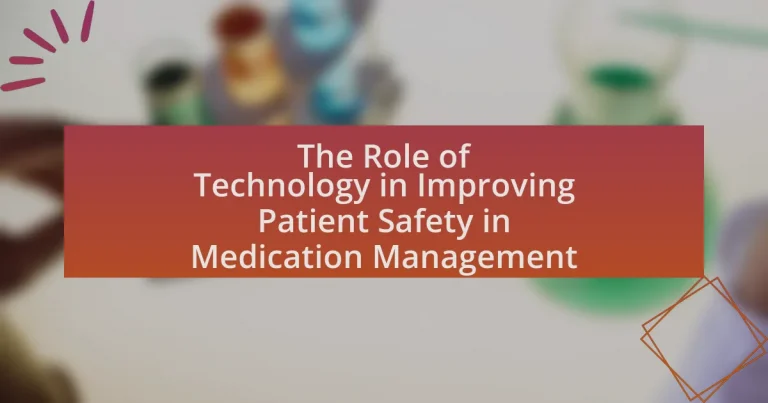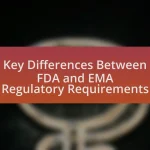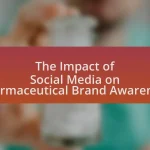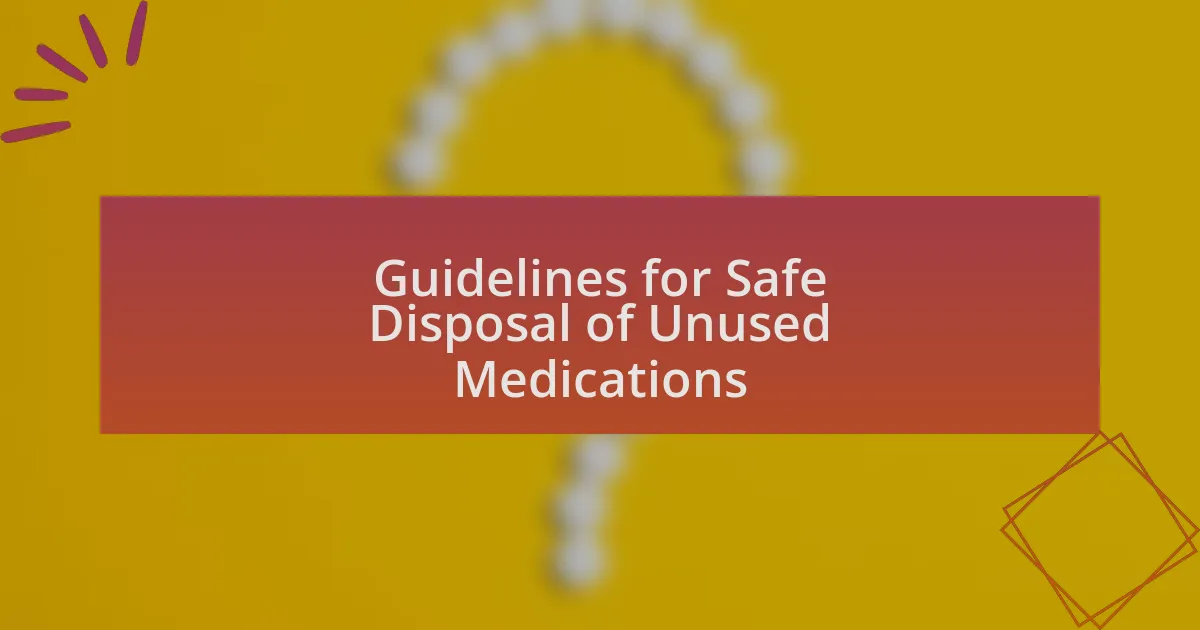The article focuses on the critical role of technology in enhancing patient safety within medication management. It highlights how electronic health records (EHRs), computerized physician order entry (CPOE) systems, and automated dispensing machines contribute to reducing medication errors and improving communication among healthcare providers. The discussion includes specific technologies utilized in medication management, their impact on patient adherence, and the challenges they address, such as medication errors and data management. Additionally, the article explores future trends, including artificial intelligence and mobile applications, which further support patient engagement and safety in medication practices.
What is the Role of Technology in Improving Patient Safety in Medication Management?
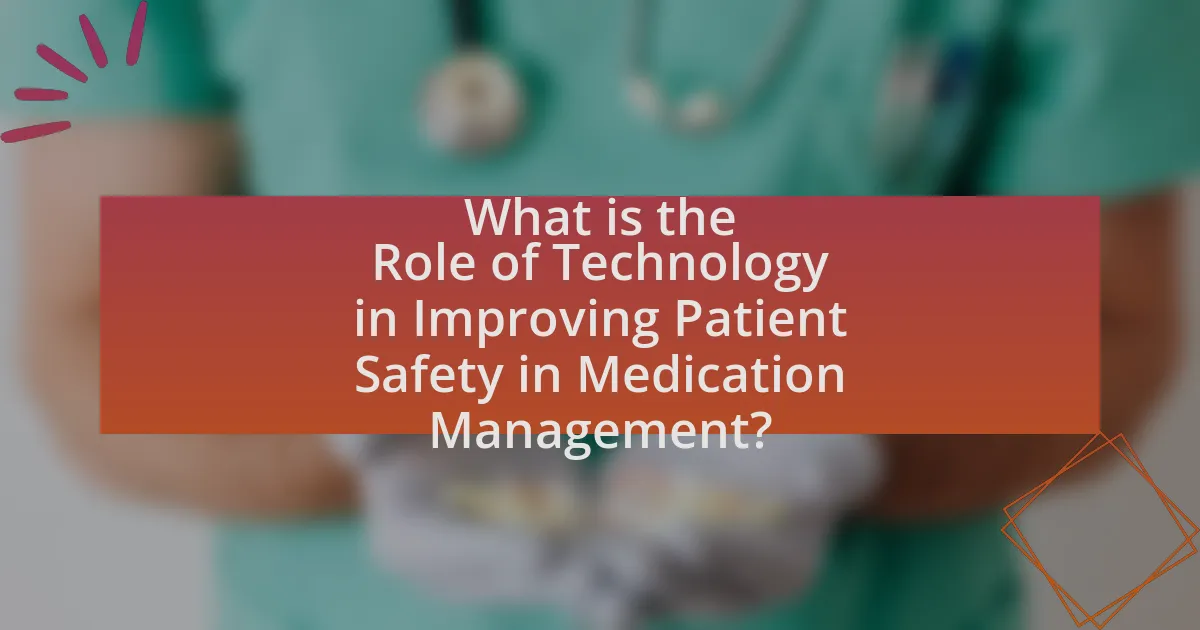
Technology plays a crucial role in improving patient safety in medication management by enhancing accuracy, reducing errors, and facilitating better communication among healthcare providers. For instance, electronic health records (EHRs) allow for real-time access to patient medication histories, which minimizes the risk of adverse drug interactions. According to a study published in the Journal of the American Medical Informatics Association, the implementation of EHRs has been associated with a 30% reduction in medication errors. Additionally, computerized physician order entry (CPOE) systems help ensure that prescriptions are legible and correctly dosed, further decreasing the likelihood of mistakes. These technological advancements not only streamline the medication management process but also foster a safer healthcare environment for patients.
How does technology enhance medication management processes?
Technology enhances medication management processes by automating and streamlining various tasks, which reduces errors and improves efficiency. For instance, electronic health records (EHRs) allow for real-time access to patient medication histories, enabling healthcare providers to make informed decisions quickly. Additionally, automated dispensing systems minimize the risk of human error by ensuring accurate medication dispensing. According to a study published in the Journal of the American Medical Informatics Association, the implementation of EHRs has been associated with a 30% reduction in medication errors. These advancements not only enhance patient safety but also facilitate better communication among healthcare teams, ultimately leading to improved patient outcomes.
What specific technologies are utilized in medication management?
Specific technologies utilized in medication management include electronic health records (EHRs), computerized physician order entry (CPOE) systems, automated dispensing machines (ADMs), and medication management software. EHRs facilitate the documentation and tracking of patient medication histories, while CPOE systems enable healthcare providers to enter medication orders electronically, reducing errors associated with handwritten prescriptions. ADMs automate the dispensing process, ensuring accurate medication distribution, and medication management software assists in monitoring patient adherence and managing drug interactions. These technologies collectively enhance patient safety by minimizing medication errors and improving the overall efficiency of medication management processes.
How do these technologies contribute to patient safety?
Technologies contribute to patient safety by enhancing the accuracy and efficiency of medication management processes. For instance, electronic prescribing systems reduce the risk of medication errors by providing clear, legible prescriptions and alerts for potential drug interactions. According to a study published in the Journal of the American Medical Informatics Association, the implementation of such systems led to a 50% reduction in prescribing errors. Additionally, barcode medication administration technology ensures that the right patient receives the correct medication by scanning barcodes on both the patient and the medication, further minimizing the risk of errors. These technologies collectively improve communication among healthcare providers and streamline workflows, ultimately leading to safer patient outcomes.
What are the key challenges in medication management that technology addresses?
Technology addresses several key challenges in medication management, including medication errors, adherence issues, and data management. Medication errors, which can occur during prescribing, dispensing, or administration, are significantly reduced through electronic prescribing systems that provide alerts for potential drug interactions and allergies. Adherence issues are tackled by mobile health applications that remind patients to take their medications on time, improving compliance rates. Furthermore, technology enhances data management by utilizing electronic health records (EHRs) that centralize patient information, allowing healthcare providers to access comprehensive medication histories and make informed decisions. These advancements collectively contribute to improved patient safety in medication management.
How does technology help reduce medication errors?
Technology helps reduce medication errors by implementing electronic prescribing systems, which enhance accuracy and efficiency in medication management. These systems minimize human errors by providing automated checks for drug interactions, allergies, and correct dosages. According to a study published in the Journal of the American Medical Informatics Association, electronic prescribing can reduce medication errors by up to 50%, demonstrating its effectiveness in improving patient safety. Additionally, barcode medication administration systems ensure that the right patient receives the correct medication at the right time, further decreasing the likelihood of errors.
What role does technology play in ensuring proper medication adherence?
Technology plays a crucial role in ensuring proper medication adherence by providing tools that facilitate reminders, tracking, and education for patients. Digital applications and devices, such as mobile apps and smart pill bottles, send alerts to patients when it’s time to take their medication, significantly reducing the likelihood of missed doses. Research indicates that patients using medication management apps demonstrate a 30% improvement in adherence rates compared to those who do not use such technology. Additionally, telehealth platforms enable healthcare providers to monitor patient progress and adjust treatment plans in real-time, further enhancing adherence.
What are the benefits of using technology in medication management?
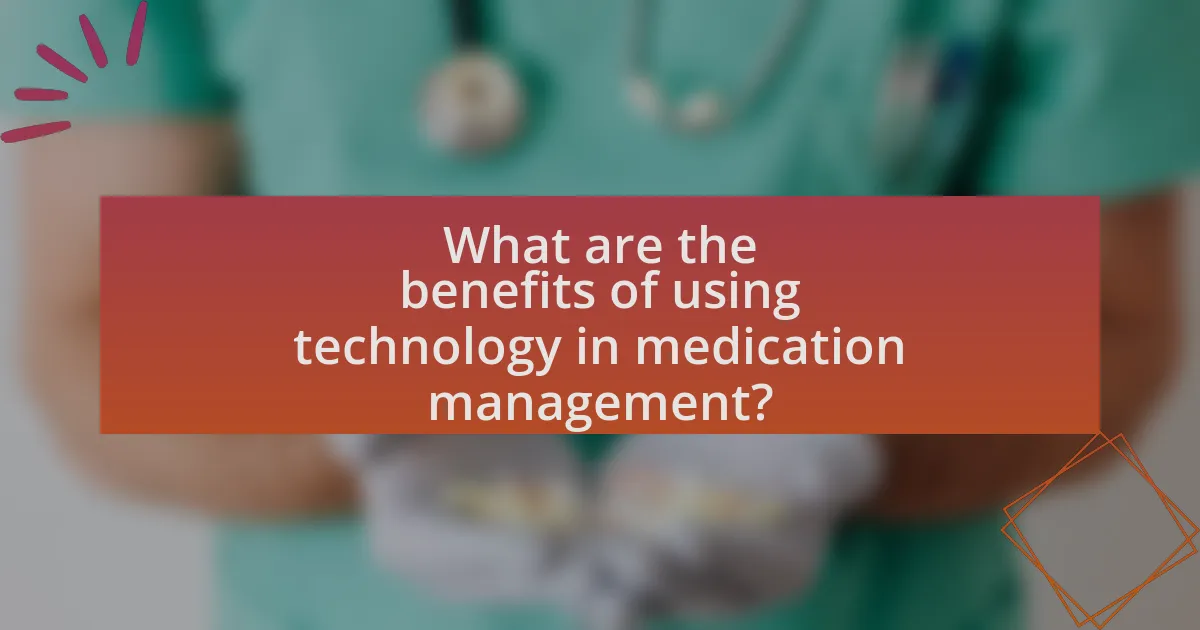
The benefits of using technology in medication management include enhanced accuracy, improved adherence, and streamlined communication. Technology reduces medication errors by automating prescription processes and providing alerts for potential drug interactions, which is supported by a study from the Journal of Patient Safety that found electronic prescribing reduced errors by 55%. Additionally, mobile health applications help patients manage their medication schedules, leading to increased adherence rates; research published in the American Journal of Managed Care indicated that patients using such apps had a 30% higher adherence rate compared to those who did not. Furthermore, technology facilitates better communication among healthcare providers, ensuring that all parties have access to up-to-date medication information, which is crucial for patient safety.
How does technology improve communication among healthcare providers?
Technology improves communication among healthcare providers by facilitating real-time information sharing and collaboration through electronic health records (EHRs) and secure messaging systems. EHRs enable providers to access and update patient information instantly, reducing the risk of errors and ensuring that all team members have the most current data. For instance, a study published in the Journal of the American Medical Informatics Association found that EHR implementation led to a 30% reduction in medication errors due to improved communication and data accessibility among providers. Additionally, secure messaging platforms allow for quick consultations and decision-making, enhancing teamwork and patient care coordination.
What systems facilitate better information sharing?
Electronic Health Records (EHR) systems facilitate better information sharing in healthcare settings. EHRs enable the seamless exchange of patient information among healthcare providers, improving coordination and reducing the risk of medication errors. According to a study published in the Journal of the American Medical Informatics Association, EHRs have been shown to enhance communication between providers, leading to a 30% reduction in adverse drug events. Additionally, health information exchanges (HIEs) further support information sharing by allowing different healthcare organizations to access and share patient data securely, thus improving patient safety in medication management.
How does improved communication impact patient outcomes?
Improved communication significantly enhances patient outcomes by fostering better understanding and adherence to treatment plans. When healthcare providers communicate effectively with patients, it leads to increased patient engagement, reduced medication errors, and improved satisfaction. Research indicates that effective communication can reduce hospital readmission rates by up to 30%, as patients are more likely to follow discharge instructions when they clearly understand them. Furthermore, studies show that patients who feel heard and understood are more likely to report better health outcomes and adherence to prescribed therapies.
What impact does technology have on patient engagement in medication management?
Technology significantly enhances patient engagement in medication management by providing tools that facilitate communication, education, and adherence. For instance, mobile health applications allow patients to track their medications, receive reminders, and access educational resources about their treatments. A study published in the Journal of Medical Internet Research found that patients using such applications reported a 30% increase in medication adherence compared to those who did not use them. Additionally, telehealth platforms enable real-time consultations with healthcare providers, fostering a collaborative approach to medication management. This integration of technology not only empowers patients but also leads to improved health outcomes and reduced medication errors.
How do patient-facing technologies enhance understanding of medication?
Patient-facing technologies enhance understanding of medication by providing accessible information and interactive tools that facilitate patient education. These technologies, such as mobile apps and online portals, allow patients to access detailed medication instructions, potential side effects, and drug interactions in real-time. Research indicates that patients who use such technologies report increased knowledge about their medications, leading to better adherence and reduced medication errors. For instance, a study published in the Journal of Medical Internet Research found that patients using a medication management app demonstrated a 30% improvement in understanding their prescribed treatments compared to those who did not use the app.
What tools are available for patients to track their medication usage?
Patients can use various tools to track their medication usage, including mobile apps, pill organizers, and electronic health records. Mobile apps like Medisafe and MyTherapy allow users to set reminders, log doses, and monitor adherence. Pill organizers help patients visually manage their medications by separating doses for different days or times. Electronic health records enable healthcare providers to track patient medication history and adherence, facilitating better communication and management of prescriptions. These tools enhance patient safety by reducing the risk of missed doses and medication errors.
What are the future trends in technology for medication management?
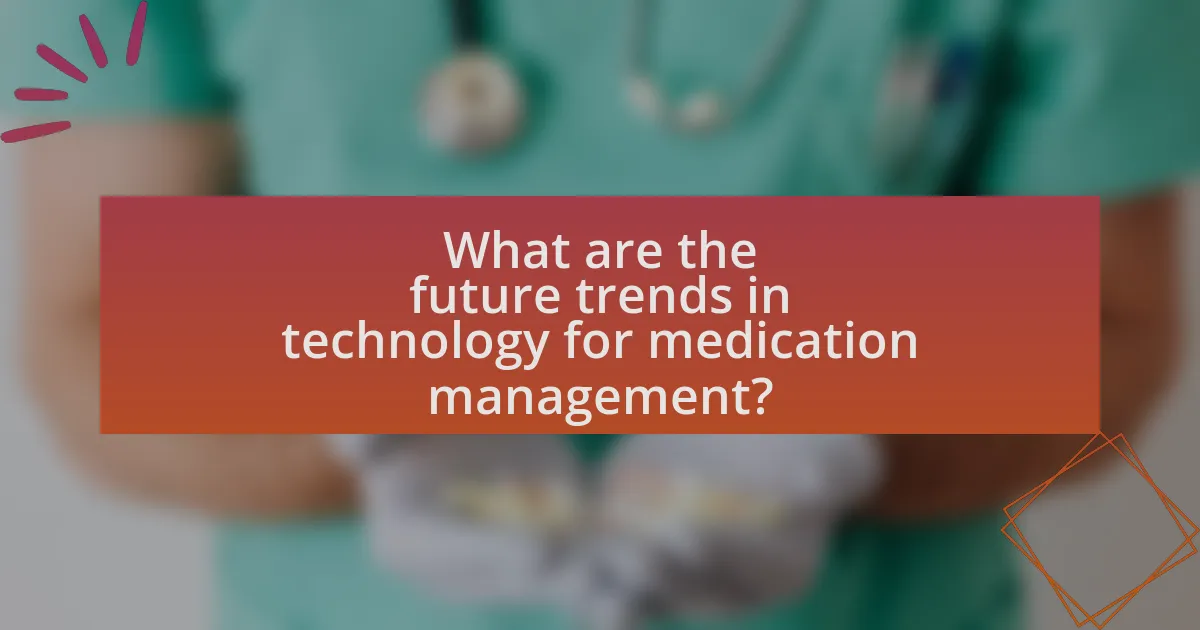
Future trends in technology for medication management include the increased use of artificial intelligence, telehealth solutions, and blockchain technology. Artificial intelligence is expected to enhance medication adherence through personalized reminders and predictive analytics, which can identify patients at risk of non-compliance. Telehealth solutions will facilitate remote consultations and medication reviews, improving access to healthcare professionals. Blockchain technology is anticipated to improve the security and traceability of medication supply chains, reducing the risk of counterfeit drugs. These trends are supported by the growing demand for efficient, secure, and patient-centered healthcare solutions.
How is artificial intelligence shaping medication management practices?
Artificial intelligence is significantly shaping medication management practices by enhancing accuracy in prescribing, monitoring patient adherence, and personalizing treatment plans. AI algorithms analyze vast amounts of patient data to identify potential drug interactions and recommend optimal dosages, thereby reducing the risk of medication errors. For instance, a study published in the Journal of the American Medical Association found that AI-driven systems can decrease prescription errors by up to 50%, demonstrating their effectiveness in improving patient safety. Additionally, AI tools facilitate real-time monitoring of patient adherence through mobile applications, allowing healthcare providers to intervene promptly when patients deviate from their prescribed regimens. This integration of AI not only streamlines medication management but also fosters a more tailored approach to patient care, ultimately leading to better health outcomes.
What are the potential applications of AI in reducing medication errors?
AI can significantly reduce medication errors through applications such as automated medication dispensing systems, clinical decision support systems, and natural language processing for prescription verification. Automated medication dispensing systems utilize AI algorithms to ensure accurate dosages and reduce human error during the dispensing process. Clinical decision support systems analyze patient data and medication interactions, providing healthcare professionals with alerts and recommendations to prevent adverse drug events. Additionally, natural language processing can enhance prescription verification by interpreting and validating handwritten prescriptions, thereby minimizing misinterpretations. These applications collectively contribute to improved patient safety and medication management efficiency.
How can AI improve personalized medication plans?
AI can improve personalized medication plans by analyzing patient data to tailor treatments based on individual health profiles. This technology utilizes machine learning algorithms to process vast amounts of data, including genetic information, medical history, and lifestyle factors, enabling healthcare providers to predict how patients will respond to specific medications. For instance, a study published in the journal “Nature” demonstrated that AI models could accurately predict drug responses in patients with various conditions, leading to more effective and safer medication choices. By integrating AI into medication management, healthcare systems can enhance patient safety and optimize therapeutic outcomes.
What role do mobile applications play in medication management?
Mobile applications play a crucial role in medication management by enhancing adherence, providing reminders, and facilitating communication between patients and healthcare providers. These applications enable users to track their medication schedules, receive alerts for dosages, and access educational resources about their prescriptions. Research indicates that mobile health applications can improve medication adherence rates by up to 50%, significantly reducing the risk of medication errors and adverse drug events. Furthermore, studies show that patients using these applications report higher satisfaction with their medication management, leading to better health outcomes.
How do these applications support patient safety?
Applications support patient safety by enhancing medication management through features like automated alerts, accurate dosage calculations, and comprehensive patient records. These functionalities minimize the risk of medication errors, which are a significant cause of adverse drug events. For instance, studies show that electronic prescribing systems can reduce prescription errors by up to 50%, thereby directly contributing to improved patient safety. Additionally, applications that provide real-time monitoring of patient medication adherence help ensure that patients take their medications as prescribed, further reducing the likelihood of complications.
What features should patients look for in medication management apps?
Patients should look for features such as medication reminders, drug interaction alerts, and easy access to prescription information in medication management apps. Medication reminders help ensure timely doses, which is crucial for adherence; studies show that reminders can improve adherence rates by up to 50%. Drug interaction alerts provide warnings about potential adverse effects when multiple medications are taken, enhancing patient safety. Additionally, easy access to prescription information allows patients to track their medications and dosages, reducing the risk of errors. These features collectively contribute to safer medication management and improved health outcomes.
What best practices should healthcare providers follow when implementing technology in medication management?
Healthcare providers should prioritize user-centered design, interoperability, and robust training when implementing technology in medication management. User-centered design ensures that technology meets the needs of healthcare professionals and patients, enhancing usability and reducing errors. Interoperability allows different systems to communicate effectively, facilitating seamless information exchange and improving care coordination. Robust training equips healthcare staff with the necessary skills to utilize technology effectively, which is crucial for minimizing medication errors. According to a study published in the Journal of Patient Safety, effective training programs can reduce medication errors by up to 30%, highlighting the importance of these best practices in enhancing patient safety.
How can providers ensure the effective use of technology in their practices?
Providers can ensure the effective use of technology in their practices by implementing comprehensive training programs for staff on the specific technologies used. Training enhances user proficiency, which is critical for maximizing the benefits of technology in medication management. For instance, studies have shown that healthcare organizations that invest in ongoing training see a 30% reduction in medication errors, as staff become more adept at using electronic health records and medication management systems. Additionally, regular assessments of technology effectiveness and user feedback can help identify areas for improvement, ensuring that the technology continues to meet the evolving needs of the practice and enhances patient safety.
What training is necessary for staff to utilize these technologies effectively?
Staff must undergo comprehensive training in technology use, focusing on specific software and hardware relevant to medication management systems. This training should include modules on system navigation, data entry accuracy, and understanding alerts and notifications generated by the technology. Evidence from the Journal of Patient Safety indicates that structured training programs significantly reduce medication errors, enhancing patient safety outcomes. Additionally, ongoing training and refresher courses are essential to keep staff updated on new features and best practices, ensuring effective utilization of these technologies.
